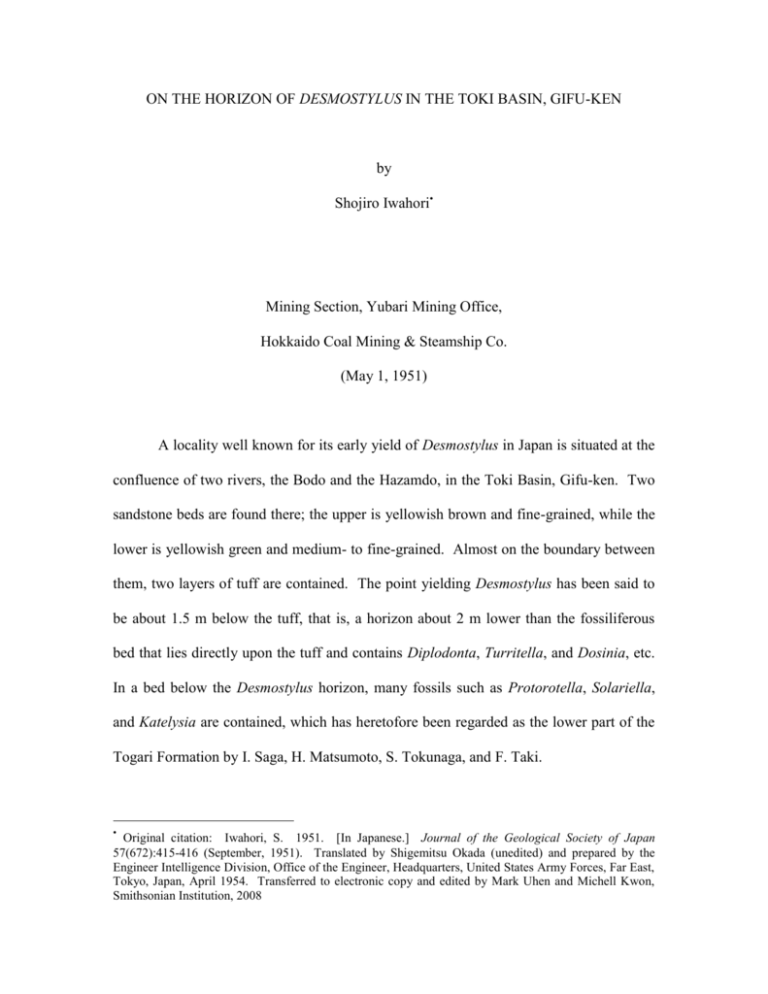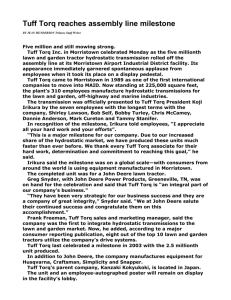on the horizon of desmostylus in the toki basin, gifu-ken
advertisement

ON THE HORIZON OF DESMOSTYLUS IN THE TOKI BASIN, GIFU-KEN by Shojiro Iwahori• Mining Section, Yubari Mining Office, Hokkaido Coal Mining & Steamship Co. (May 1, 1951) A locality well known for its early yield of Desmostylus in Japan is situated at the confluence of two rivers, the Bodo and the Hazamdo, in the Toki Basin, Gifu-ken. Two sandstone beds are found there; the upper is yellowish brown and fine-grained, while the lower is yellowish green and medium- to fine-grained. Almost on the boundary between them, two layers of tuff are contained. The point yielding Desmostylus has been said to be about 1.5 m below the tuff, that is, a horizon about 2 m lower than the fossiliferous bed that lies directly upon the tuff and contains Diplodonta, Turritella, and Dosinia, etc. In a bed below the Desmostylus horizon, many fossils such as Protorotella, Solariella, and Katelysia are contained, which has heretofore been regarded as the lower part of the Togari Formation by I. Saga, H. Matsumoto, S. Tokunaga, and F. Taki. • Original citation: Iwahori, S. 1951. [In Japanese.] Journal of the Geological Society of Japan 57(672):415-416 (September, 1951). Translated by Shigemitsu Okada (unedited) and prepared by the Engineer Intelligence Division, Office of the Engineer, Headquarters, United States Army Forces, Far East, Tokyo, Japan, April 1954. Transferred to electronic copy and edited by Mark Uhen and Michell Kwon, Smithsonian Institution, 2008 On the contrary, K. Fujita and T. Ikukoshi have recently referred to the lastmentioned bed as the Tsukiyoshi Formation (Tu2), and considered the Desmostylus bed to be above the tuff and regarded it as the Togari Formation. Thus, Fujita and Ikukoshi differ in opinion with me about the Desmostylus horizon. Such a difference should not exist; nevertheless it still exists because of the following two facts: (1) The yield of the fossil happened several decades ago, and regarding a horizon of which no descriptions have been made, we have no basis for decision except for the native’s recollection; (2) the natives who cooperated with Fujita and Ikukoshi, and those cooperating with me, were different, and each of us believed his own account. Mr. Fukuoka, from whom I heard of the locality, had accompanied Dr. Tokunaga and Dr. Makiyama to the actual place. In addition, I. Saga, who had given the name “Togari Formation,” has clearly described that Desmostylus was contained in this formation, and on his geologic map the locality is colored as the Togari Formation. For these reasons, I cannot agree with the opinion of Fujita and Ikukoshi. Recently, another Desmostylus has been discovered in the Toki Basin, and I have also visited there in order to clear up the question. The new locality is situated on a mountain commonly called Inkyo-yama, behind the Tokitsu Middle School at Izumi, Tokitsu-cho, 4.9 km west of the older locality. I have recognized the new locality as belonging to almost the same horizon as that described above, that is, the bed yielding new Desmostylus is a yellowish-gray tuffaceous sandstone of fine grains containing Turritella hatai, Paphia siratoria, Macrocallista sp., etc., and lies about 4 m below a layer of tuff that may be correlated to the tuff previously described. The Desmostylus bed is underlain by the Tsukiyoshi phase of about 2 m thick, which is again underlain by the Hiyoshi phase of more than 10 m thick, containing Miogypsina and corals. Therefore, the Desmostylus horizon in the older locality may be regarded as nearly the same as that in the newer locality. Were the horizons of two Desmostylus not nearly the same, the Desmostylus bed would be clearly separated from the upper and lower beds with respect to the rock phases. The lower beds are the Tsukiyoshi Formation, deposited in a warm sea, which may be divided into two phases, viz., the Tsukiyoshi phase of inner-bay deposits characterized by Vicarya, and the Hiyoshi phase of open-sea deposits containing Miogypsina and Operculina. The upper beds are the Yamanouchi Formation, the coldsea deposits with Ancistrolepis, Fulgoralia, Lunetia, etc., and the Desmostylus-bearing bed, i.e., the Togari Formation can roughly be divided into two parts according to the accompanying fossils. The lower part contains Protorotella, Solariella, Katelysia, and Vicaryella, which do not always indicate a cold sea, but rather have a close connection with the fauna of the Tsukiyoshi Formation. The upper part, on the contrary, is characterized by Diplodonta, Dosina, Turritella, etc. Therefore, it may be concluded that the lower part of the Togari Formation indicates signs of having been deposited in a somewhat warmer sea, whereas the upper part almost lacks such characteristics. In a word, reference of the Desmostylus-bearing bed to the Togari Formation is no longer a problem to be discussed. The Togari Formation, defined as above, was not such a coldsea deposit as has heretofore been regarded, but that of a transitional stage between the warm sea in the age of the Tsukiyoshi Formation and the cold sea of the Yamanouchi Formation.










